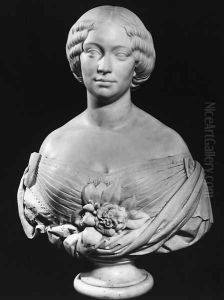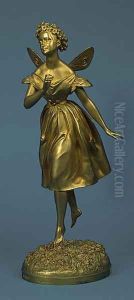Jean Auguste Barre Paintings
Jean Auguste Barre was a prominent French sculptor and medallist, born on September 25, 1811, in Paris. Barre was known for his work in portrait sculpture and was particularly renowned for his medallions. His artistic talents were recognized early, and he became a student of the esteemed French sculptor Jean-Pierre Cortot. Under Cortot's tutelage, Barre honed his skills and developed a keen sense for detail and composition that would distinguish his later works.
Barre's career was marked by a number of significant achievements. In 1833, he was awarded the Prix de Rome for sculpture, which provided him the opportunity to study at the French Academy in Rome, an experience that had a profound influence on his artistic development. After his return to France, Barre became one of the most sought-after portraitists of his time, creating busts and medallions of many notable figures from various spheres, including politics, the arts, and royalty.
His works were characterized by their realism and the delicate treatment of his subjects' features, capturing both their physical likeness and a sense of their character. Among his notable works is the portrait of Napoleon III, which became the official effigy and was widely reproduced. Barre's talent in engraving and his mastery of the medallion form also led him to be appointed as the Chief Engraver at the Paris Mint, a position he held from 1855 until his death.
Jean Auguste Barre's influence extended beyond his own creations; he was also a teacher and mentor to a number of other artists. His works were exhibited in the Salon, where he achieved considerable success and accolades. Despite the prominence of his sculptures and medallions during his lifetime, Barre remained dedicated to his art and continued to produce works that were celebrated for their craftsmanship and artistry.
Barre's legacy is preserved in the collections of various museums and institutions, where his sculptures and medallions continue to be admired. He passed away on February 5, 1896, in Paris, having left behind a body of work that reflects the artistic vigor of 19th-century France and the skill of a master sculptor and medallist.

